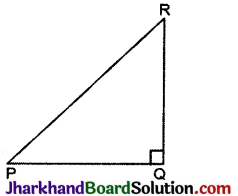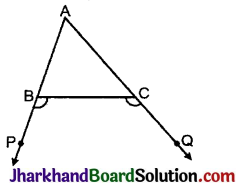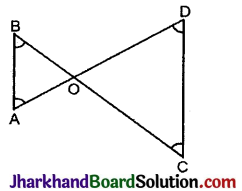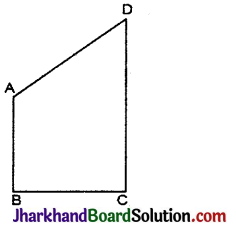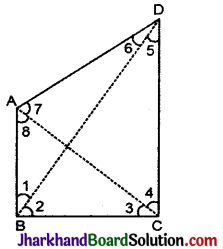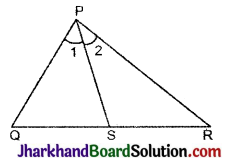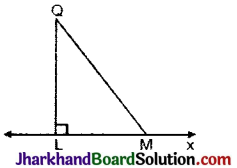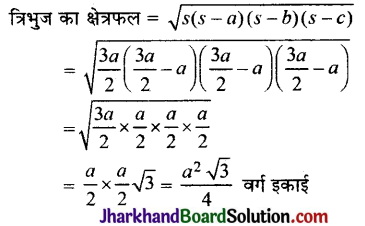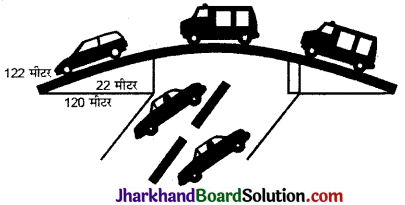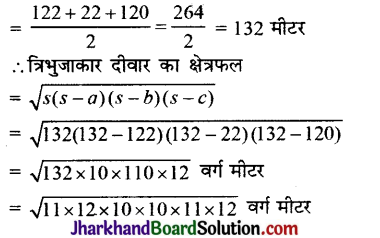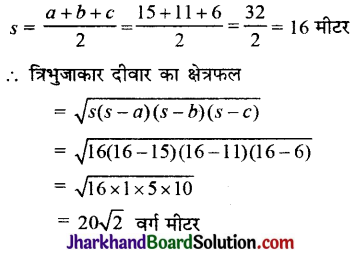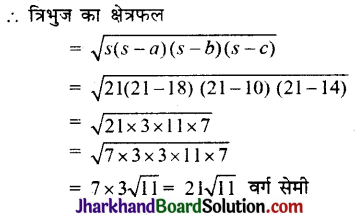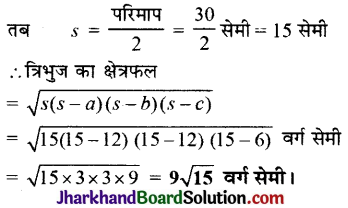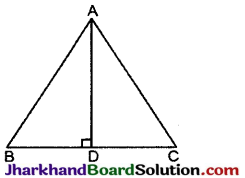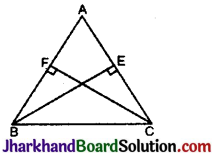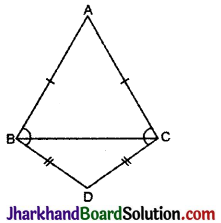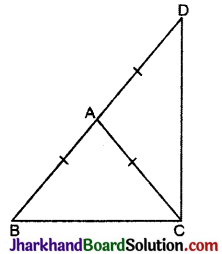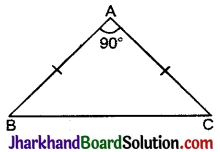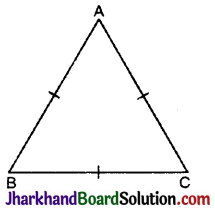Jharkhand Board JAC Class 9 English Solutions Beehive Poem 4 The Lake Isle of Innisfree Textbook Exercise Questions and Answers.
JAC Board Class 9 English Solutions Beehive Poem 4 The Lake Isle of Innisfree
JAC Class 9 English The Lake Isle of Innisfree Textbook Questions and Answers
Thinking about the Poem
Question 1.
What kind of place is Innisfree ?
इनिसफ्री किस प्रकार का स्थान है ?
Answer:
Innisfree is a lake island. It is a simple, natural place, full of beauty and peace.
इनिसफ्री एक झील वाला टापू है । यह एक साधारण, प्राकृतिक स्थान है जो सुन्दरता व शांति से भरा हुआ है।
(i) the three things the poet wants to do when he goes back there. (Stanza – I)
उन तीन कार्यों के बारे में सोचिये जिन्हें कवि तब करना चाहता है जब वह वहाँ वापिस जायेगा ।
Answer:
On going back the poet wants to :
- build a small cabin of clay and wattles.
- grow nine bean rows for food.
(ii) what he hears and sees there and its effect on him. (Stanza (II)
कवि जो वहाँ सुनता व देखता है तथा इसके उस पर पड़ने वाले प्रभाव के
Answer:
He hears cricket’s singing and peace comes dropping there. He sees the glimmer of the midnight, purple glow of the noon and evenings full of linnets. He feels peace and tranquility in his heart.
वहाँ झींगुरों का गाना व खामोशी का छा जाना (उतरना) सुनता है। वह अर्द्धरात्रि की झिलमिलाहट, दोपहर की बैंगनी रंग की आभा, व लिनेट पक्षियों से भरी संध्या को देखता है। वह अपने अन्तर्मन में शांति व विश्रांति महसूस करता है ।
![]()
(iii) what he hears in his “heart’s core” even when he is far away from Innisfree. (Stanza III)
इनिसफ़ी से बहुत दूर होने के बावजूद जो वह सोचता है, उसके विषय में लिखिए ।
Answer:
Even when the poet is far away from Innisfree, he hears the low sounds of lake water lapping on the shore in his heart’s core.
यद्यपि कवि इनिसफ्री से बहुत दूर है फिर भी वह अपने अन्तर्मन में झील के किनारे पर पानी के टकराने से होने वाली छप छप की मंद मंद ध्वनि को सुनता है ।
Question 2.
By now you may have concluded that Innisfree is a simple, natural place, full of beauty and peace. How does the poet contrast it with where he now stands? (Read Stanza III)
अब तक शायद आप यह निष्कर्ष निकाल चुके होंगे कि इनिसफ्री सुन्दरता व शांति से भरा एक साधारण प्राकृतिक स्थल है । कवि उस स्थान से जहाँ वह अभी खड़ा है, इसकी किस प्रकार तुलना करता है ?
Answer:
The poet contrasts lake water lapping on the island to the roadway and grey pavements of London that symbolise dullness. On the other hand, Innisfree provides the poet peace, beauty and happiness.
कवि टापू पर झील के पानी की छप छप की तुलना लंदन की सड़क व स्लेटी पंगडंडियों से करता है जो नीरसता की प्रतीक हैं। दूसरी ओर, इनिसफ्री कवि को शांति, सुन्दरता व प्रसन्नता प्रदान करता है ।
Answer: 3.
Do you think Innisfree is only a place, or a state of mind ? Does the poet actually miss the place of his boyhood days?
आपके विचार में क्या इनिसफ्री केवल एक स्थान है या कोई मानसिक स्थिति है ? क्या कवि वास्तव में उस स्थान को याद करता है जहाँ उसने अपना लड़कपन गुजारा था ?
Answer:
Innisfree is an actual place which is full of beauty and peace. Yes, the poet actually misses the place of his boyhood days. He is fed up with busy and noisy life of the city.
इनिसफ्री एक वास्तविक स्थान है जो कि सुन्दरता व शांति से भरा हुआ है । हाँ, कवि अपने लड़कपन – के स्थान को वास्तव में याद करता है । वह शहर के व्यस्त व शोरगुल भरी जिन्दगी से ऊब गया है ।
![]()
II.
1. Look at the words the poet uses to describe what he sees and hears at Innisfree.
कवि इनिसफ्री में जो कुछ देखता है और सुनता है उसका वर्णन कवि जिन शब्दों में करता है उन शब्दों को देखिये
Answer:
- bee-loud glade
- evenings full of the linnet’s wings
- lake water lapping with low sounds
What pictures do these words create in your mind?
इन शब्दों से आपके मन में कैसा चित्र उभरता हैं ?
(i) bee-loud glade – The poet will be standing on the clear area of a jungle. It will be surrounded by blooming flowers. There will be bee hives. Thus, the place will be resounded with the buzzing of the bees.
कवि एक जंगल में साफ ( खुली) जगह पर खड़ा होगा । यह स्थान खिलते हुए फूलों से घिरा होगा । वहाँ मधुमक्खियों के छत्ते होंगे । इस प्रकार से यह स्थान मधुमक्खियों की भिनभिनाहट से गूँजता होगा ।
(ii) evenings full of the linnet’s wings – Linnets will return to their nests. They will fly here and there in the sky at that time. The sky will be covered with them. It will seem as if the ‘sky were full of linnet’s wings.
संध्या के समय लिनेट पक्षी अपने- अपने घोंसलों में लौटेंगे । वे उस समय आकाश में इधर-उधर उड़ेंगे। आकाश उनसे ढका होगा । ऐसा प्रतीत होगा मानो आकाश लिनेट पक्षियों के पंखों से भरा हुआ हो ।
(iii) lake water lapping with low sounds – There is a lake. Its waves are rippling and gently striking the shore that creates a pleasant murmuring sound.
वहाँ पर एक झील है । इसकी लहरें उठ रही हैं और हल्के से किनारे से टकरा रही हैं जो कल-कल की सुहावनी ध्वनि उत्पन्न करती है ।
2. Look at these words;
इन शब्दों को देखिये;
…………………… peace comes dropping slow
Dropping from the veils of the morning to where the cricket sings.
What do these words mean to you ? What do you think “comes dropping slow……. from the veils of the morning ” ? What does ‘to where the cricket sings’ mean?
आपके अनुसार इन शब्दों का क्या अर्थ है ? ‘प्रातः काल के घूँघट से धीरे-धीरे उतरना’ से आप क्या समझते हैं? ‘जहां झींगुर गाते हैं’ से क्या तात्पर्य है ?
Answer:
A thin sheet of darkness at the lighted face of early morning has been called the veil of morning. When night insects stop making noise, then the natural peace comes out from its hidden place through this morning veil. This state of peace remains all day long from morning till evening until crickets start singing again.
![]()
प्रातः काल के प्रकाश से भरे चेहरे पर अंधेरे की हल्की चादर को प्रातः काल का घूँघट कहा गया है । जब रात्रि के धीर शान्त हो जाते हैं तो प्रातः के इस घूँघट से होकर प्राकृतिक शान्ति अपने प्राकृतिक स्थलों पर धीरे-धीरे आती है । शान्ति की यह स्थिति प्रातः से सांय तक पूरे दिन तब तक रहती है जब तक कि झींगुर पुन: (रात्रि होने पर) अपना गाना शुरू नहीं कर देते ।
JAC Class 9 English The Lake Isle of Innisfree Important Questions and Answers
Short Answer Type Questions
Question 1.
Why does the poet want to go to Innisfree ?
कवि इनिसफ्री क्यों जाना चाहता है ?
Answer:
Innisfree is the place where the poet spent his boyhood. It is a place full of natural beauty. The poet is fed up of the busy and noisy city life. So he wants to go to Innisfree to live in peace.
इनिसफ्री वह स्थान है जहाँ कवि ने अपना बचपन बिताया था । यह प्राकृतिक सौन्दर्य से परिपूर्ण स्थान है । कवि शहर के व्यस्त व शोरगुल से युक्त जीवन से ऊब गया है । इसलिए वह शान्ति से रहने के लिए इनिसफ्री जाना चाहता है ।
Question 2.
How will the poet live there ?
कवि वहाँ कैसे रहेगा ?
Answer:
The poet will build a small cabin there. It will be built of clay and wattles. He will have nine been-rows there for his food and a hive for the honeybees. At that place of natural beauty, he will live alone.
कवि वहाँ एक छोटी-सी कुटिया बनायेगा । यह मिट्टी और खपच्चियों की बनी होगी । वह वहाँ अपने भोजन के लिए नौ पंक्तियों में सेम के पौधे लगायेगा और मधुमक्खियों के लिए उनका एक छत्ता भी रखेगा । प्राकृतिक सौन्दर्य से परिपूर्ण उस स्थान पर वह अकेला रहेगा।
Question 3.
Describe the peaceful atmosphere of Innisfree.
इनिसफ्री के शान्त वातावरण का वर्णन कीजिए ।
Answer:
Innisfree is a lake island surrounded by natural beauty. Peace reigns there all day long. Only sounds that can be heard thereare of birds and insects. The place is totally free from the noise of city life.
इनिसफ्री प्राकृतिक सौन्दर्य से घिरा हुआ एक झील वाला टापू है । वहाँ दिन-भर शान्ति का साम्राज्य रहता है । वहाँ केवल पक्षियों और कीटों की आवाज़ें सुनाई देती हैं। वह स्थान शहरी-जीवन के शोरगुल से पूर्णतः मुक्त है।
Question 4.
Discuss the poem as a lyric.
एक गीत के रूप में कविता पर चर्चा कीजिए ।
Answer:
Lyric is a small poem that can be sung. It has a constant rhyme scheme.’The Lake Isle of Innisfree’ is divided into three stanzas of four lines each. Every stanza has a constant rhyme scheme. It is- abba, abba, abba.
गीत वह छोटी कविता होती है जिसे गाया जा सके । इसकी एक नियत लय-योजना होती है । ‘The Lake Isle of Innisfree’ कविता चार-चार पंक्तियों के तीन पदों में बँटी है । प्रत्येक पद की एक नियत लय-योजना है । यह है- abba, abba, abba.
![]()
Question 5.
Describe the beauty of Innisfree.
इनिसफ्री के सौन्दर्य का वर्णन कीजिए ।.
Answer:
Innisfree is a place of complete natural beauty. Mornings bring peace there and noons have a purple glow. Evenings are full of linnet’s wings and midnights have glimmer of moonlight.
इनिसफ्री पूर्ण प्राकृतिक सौन्दर्ययुक्त स्थान है.। वहाँ प्रातःकाल के समय शान्ति होती है, दोपहर बैंगनी रंग की अरुणिमा से भरी होती है, संध्या के समय आकाश लिनेट पक्षियों से भरा होता है और अर्द्धरात्रि को चाँदनी की झिलमिलाहट होती है ।
Question 6.
What does the poet hear in his heart and when ?
कवि को अपने हृदय में क्या सुनाई देता है और कब ?
Answer:
When the poet is standing on the roadway or on grey pavement, he hears low sounds of nature in his heart. These are the sounds of the lake water lapping by the shore.
जब कवि सड़क पर या स्लेटी रंग की पगडंडी पर खड़ा होता है, उस समय उसे अपने हृदय में प्रकृति की धीमी आवाज़ें सुनाई देती हैं। ये आवाज़ें झील के किनारे पर पानी के टकराने से उत्पन्न होती हैं।
Question 7.
Give an account of the poet’s love for nature on the basis of this poem.
इस कविता के आधार पर कवि के प्रकृति-प्रेम का वर्णन कीजिए ।
Answer:
The poet wants to go to a place of natural beauty and live there. His description of Innisfree shows that he is deeply attached to nature. Even when he is far away from that place, he feels its natural beauty in his heart.
कुवि एक प्राकृतिक सौन्दर्ययुक्त स्थान पर जाकर रहना चाहता है। उसके द्वारा किये गये इनिसफ्री के वर्णन से पता चलता है कि उसे प्रकृति से गहरा लगाव है । यहाँ तक कि जब वह प्राकृतिक वातावरण से दूर होता है, तब भी इसके प्राकृतिक सौन्दर्य को अपने हृदय में अनुभव करता है ।
![]()
Question 8.
How do we know that the poet is fed up of city-life?
हमें कैसे पता चलता है कि कवि शहरी जीवन से ऊब गया है ?
Answer:
The poet wishes to go to Innisfree which is a place full of natural beauty. He wants to make a small cabin there to live peacefully among natural scenes. This shows that he is fed up of city-life.
कवि इनिसफ्री जाना चाहता है जो कि एक प्राकृतिक सौन्दर्ययुक्त स्थान है । वह वहाँ एक छोटी-सी कुटिया बनाकर प्रकृति के बीच में शान्ति से रहना चाहता है । इससे पता चलता है कि बह शाही- जीवन से ऊब गया है ।
The Lake Isle of Innisfree Summary and Translation in Hindi
About the Poem
यह प्रसिद्ध कविता इनिसफ्री की शांति व प्रशान्ति के लिए कवि की चाह को प्रकट करती है, यह (इनिसफ्री) वह स्थान है जहाँ उसने एक बच्चे के रूप में बहुत सारा समय व्यतीत किया था। यह कविता एक गीत है ।
Word-Meanings And Hindi Translation
Stanza 1. I will arise.. bee-loud glade. (Lines 1-4)
Word-Meanings: arise ( अराइज्ञ) = उठना । cabin (केबिन्)=a small wooden cottage, लकड़ी से बना छोटा मकान, कुटिया । clay (क्ले) = mud, मिट्टी, गारा । wattles (वॉटल्ज्) = twisted sticks for making fences, walls, दीवार, बाड़ इत्यादि बनाने की मुड़ी हुई लकड़ी की टहनियाँ, खपच्चियाँ । bean(बीन) = सेम। rows ( रॉज़ )= कतारें। hive (हाइव् ) = honeycomb, मधुमक्खी का छत्ता । honeybee ( हनिबी )= मधुमक्खी। alone (अलोन ) = अकेला । bee-loud (बी-लाउड्) = loud noise due to the sound of honeybees, मधुमक्खियों की भिनभिनाहट से गूँजता हुआ। glade(ग्लेड्) = clearing, open space in the forest, जंगल में खुला स्थान।
Stanza II. And I shall have. linnet’s wings. (Lines 5-8)
Word -Meanings : peace (पीस्) = शांति । dropping ( ड्रॉपिड) = (here) coming, आती हुई । veils ( वेल्ज्ञ) = coverings, पर्दे, आँचल, घूँघट । cricket (क्रिकिट्) = a small insect, झींगुर । midnight (मिड्नाइट्) = मध्यरात्रि । glimmer (ग्लिमर्) = a faint light, झिलमिलाहट, टिमटिमाहट । purple (पःप्ल्) = जामुनी, बैंगनी। glow (ग्लो) = shine, अरुणिमा, दीप्ति, चमक । linnet (लिनेट) =a small brown and grey bird with a short beak, एक प्रकार का छोटा भूरा व स्लेटी रंग का पक्षी जिसकी चोंच छोटी होती है।
हिन्दी अनुवाद – और मुझे वहाँ कुछ शांति मिलेगी, क्योंकि शांति धीरे-धीरे आती है, प्रातःकाल के आँचल पे आती हुई वहाँ तक जाती है जहाँ पर झींगुर गाते हैं (अर्थात् सुबह से शाम तक शान्ति रहती है) । जहाँ पध्यरात्रि के समय प्रकाश टिमटिमाता रहता है, और दोपहर को बैंगनी रंग की सी अरुणिमा (दीप्ति) होती है तथा संध्या (उड़ते हुए) लिनेट पक्षी के पंखों से भर जाती है ।
![]()
Stanza III. I will arise. heart’s core. (Lines 9-12)
Word – Meanings : lake ( लेक् ) = झील, सरोवर । lapping (लैपिङ) = sound of water striking he shore, तट आदि से टकराते हुए छप-छप करना। shore (शॉः:) = झील का तट । pavements (पेवमन्ट्स) = footpaths, पगडंडियाँ। grey (ग्रे) = स्लेटी रंग । core (कॉ:) = innermost part, अन्तर्मन, मर्म, दिल की ाहराई ।
हिन्दी अनुवाद – अब मैं उठकर जाऊँगा क्योंकि हमेशा दिन और रात मैं झील के पानी को तट पर टकराकर नद्धिम आवाज में छप-छप करते हुए सुनता हूँ। जब मैं सड़क मार्ग पर या स्लेटी पगडंडियों पर खड़ा होता तो मैं इसे अपनें दिल की गहराई (अन्तर्मन) में सुनता हूँ।
Explanation With Reference To Context & Comprehension Question –
Stanza-1.
I will arise and go now, and go to Innisfree,
And a small cabin build there, of clay and wattles made :
Nine bean-rows will I have there, a hive for the honeybee,
And live alone in the bee-loud glade.
Reference: These lines have been taken from the poem ‘The Lake Isle of Innisfree’ composed by the poet William Butler Yeats.
Context: In these lines, the poet tells about his wish to go to Innisfree. He also tells how he will live there.
Explanation: The poet says that he will get up now and go to Innisfree. There he will build a small cabin of clay and wattles. He will sow there beans in nine rows. There will be a hive for the honeybee. There he will live alone in the glade that will be full of the buzz of bees.
संदर्भ : ये पंक्तियाँ कवि William Butler Yeats द्वारा रचित कविता “The Lake Isle of Innisfree’ से ली गई हैं।
प्रसंग : इन पंक्तियों में कवि इनिसफ्री जाने की अपनी इच्छा के बारे में बताता है। वह यह भी बताता है कि वह वहाँ किस प्रकार रहेगा ।
व्याख्या : कवि कहता है कि अब वह उठेगा और इनिसफ्री जायेगा । वहाँ वह मिट्टी व तिनकों से एक छोटी सी कुटिया बनायेगा । वहाँ वह नौ पंक्तियों में सेम के पौधे उगायेगा । वहाँ मधुमक्खियों के लिए एक छत्ता होगा। वहाँ वह मधुमक्खियों की आवाज़ से गूँजते कुँज में अकेला रहेगा।
Questions
1. Why does the poet want to go to Innisfree ?
2. Where will the poet live in Innisfree ?
3.What will the cabin be made of by the poet ?
4. What will the poet have there?
Answers
1. The poet wants to go to Innisfree to get peace there.
2. The poet will live in the bee-loud glade in Innisfree.
3. The cabin will be made of clay and wattles.
4. He will have nine bean rows and a hive for the honeybee there.
Stanza 2
And I shall have some peace there, for peace comes dropping slow
Dropping from the veils of the morning to where the cricket sings;
There midnight’s all a glimmer and noon a purple glow,
And evenings full of the linnet’s wings.
Reference: These lines have been taken from the poem
‘The Lake Isle of Innisfree’ composed by the poet William Butler Yeats.
Context: In these lines the poet describes what type of a place Innisfree is.
Explanation: The poet says that while living in Innisfree, he will have some peace. There peace reigns from morning till night. Midnights are full of glimmer there and noons have a purple glow. In the evening linnet birds fly in the sky. Then the sky is filled with the wings of linnet.
संदर्भ : ये पंक्तियाँ कवि William Butler Yeats द्वारा रचित कविता ‘The Lake Isle of Innisfree’ से ली गई हैं।
प्रसंग : इन पंक्तियों में कवि वर्णन करता है कि इनिसफ्री किस प्रकार का स्थान है।
व्याख्या : कवि कहता है कि इनिसफ्री में रहते हुए उसे कुछ शान्ति मिलेगी। वहाँ प्रात: काल से रात्रि तक शान्ति का साम्राज्य रहता है। वहाँ अर्द्धरात्रियाँ चमकीली होती हैं और दोपहर बैंगनी आभा से परिपूर्ण होती हैं। सायंकाल लिनेट पक्षी आसमान में उड़ते, तब आकाश लिनेट पक्षी के पंखों से भर जाता है।
![]()
Questions
1. How does peace come there?
2. How does midnight look at Innisfree?
3. Describe the noon at Innisfree.
4. How are the evenings at Innisfree?
Answers
1. Peace comes slowly dropping from the veils of the morning.
2.The midnight is full of glimmer of moonlight there.
3.The noon has the purple glow there.
4. Evenings are full of linnet’s wings at Innisfree.
Stanza 3.
I will arise and go now, for always night and day
I hear the lake water lapping with low sounds by the shore;
While I stand on the roadway, or on the pavements grey,
I hear it in the deep heart’s core.
Reference: These lines have been taken from the poem ‘The Lake Isle of Innisfree’ composed by the poet William Butler Yeats.
Context: These lines describe the poet’s great fascination for Innisfree, a place full of natural beauty.
Explanation: The poet says that he will get up now and go to Innisfree. He pines so much for the place that even while standing on the roadway or on the grey coloured pavement, he thinks of Innisfree only. He hears the sound of water lapping of the lake by the shore in the depth of his heart.
संदर्भ : ये पंक्तियाँ कवि William Butler Yeats द्वारा रचित कविता ‘The Lake Isle of Innisfree’ से ली गई हैं।
प्रसंग : ये पंक्तियाँ प्राकृतिक सौन्दर्य से परिपूर्ण स्थान इनिसफ्री के प्रति कवि के अत्यधिक आकर्षण का वर्णन करती हैं।
व्यारव्या : कवि कहता है कि अब वह उठेगा और इनिसफ्री जायेगा । उसे उस स्थान की इतनी चाह है कि सड़क पर या पैदल मार्ग पर खड़े रहने के समय भी वह इनिसफ्री के विषय में ही सोचता है। उसे अपने हृदय की गहराई में झील के किनारे पर उत्पन्न होने वाली पानी की छप छप की आवाज सुनाई देती है ।
![]()
Questions
1. What does the poet hear there?
2. Where is the poet standing?
3. What is the effect of the sound of iake water on the poet?
4. What does the poet’s hearing it in the deep core of the heart express?
Answers
1. The poet hears the lake water lapping with low sounds by the shore.
2. The poet is standing either on the roadway or on the pavement in a city.
3. The poet feels the sound of lake water in his deep heart’s core.
4. This expresses his deep love for nature.
